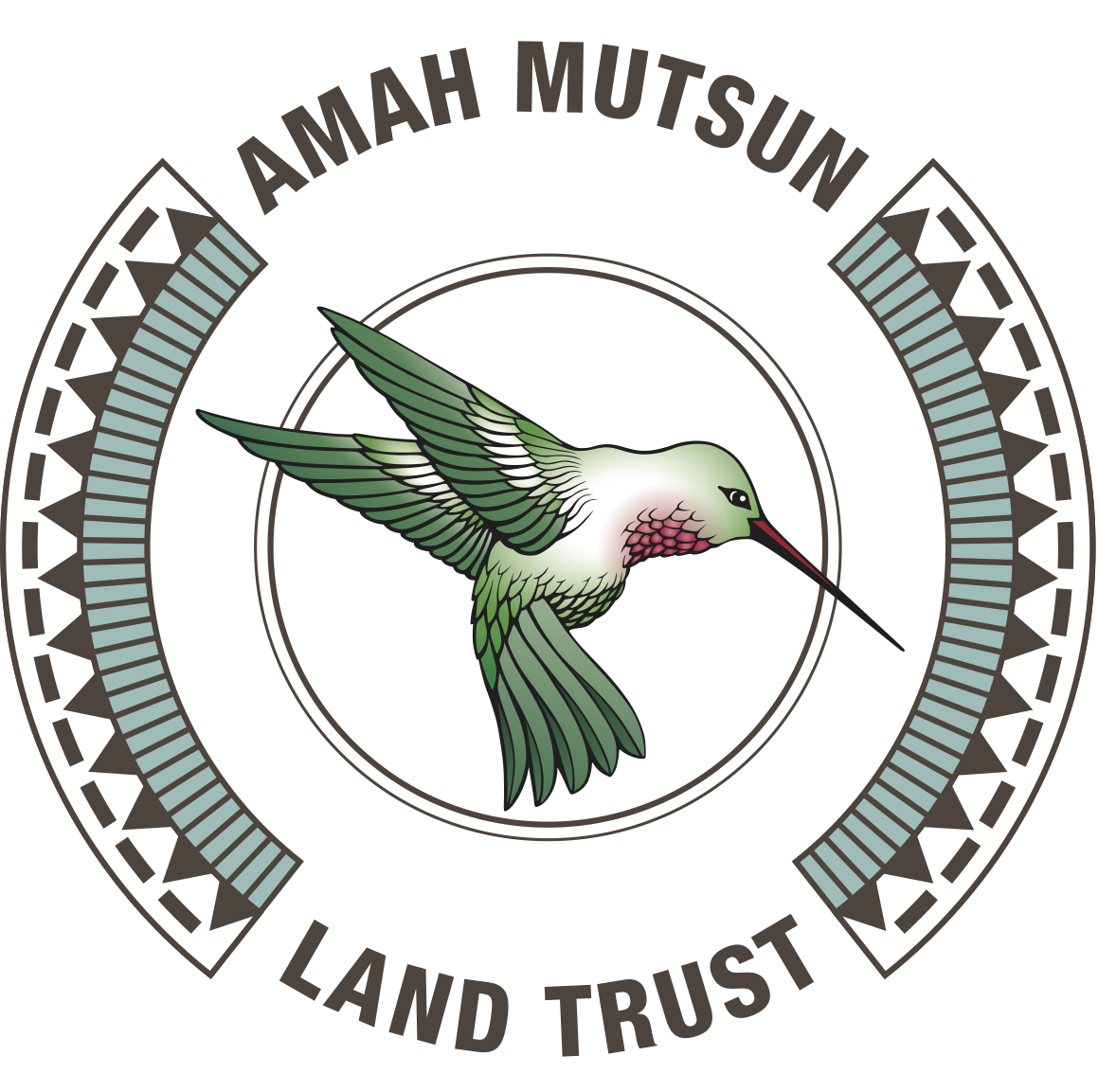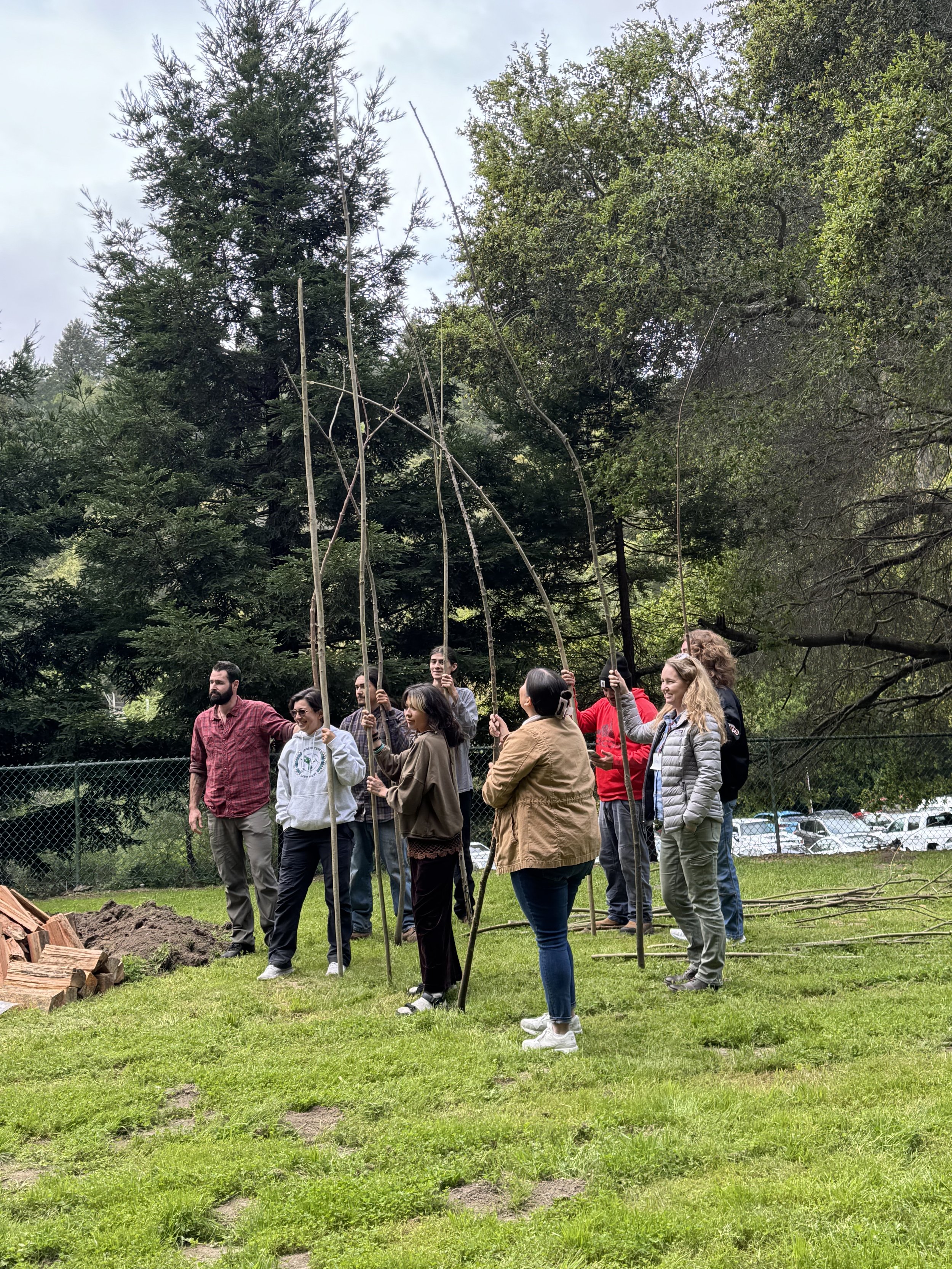Summer 2025 Newsletter
To return to the newsletter, click here.
hatuhte makke amuypu: “Gathering to teach ourselves”
Reflections from AMLT’s Gathering of Native Americans (GONA) Retreat
By Adam French, AMLT Director of Programs; Eleanor Castro, Amah Mutsun Tribal Band Elder; and Millie Bravo-Garris, AMTB Tribal Elder and AMLT Tribal Board Member
Smiles and silly poses at the GONA by AMTB members, AMLT staff and Board and close partners.
Summary by Adam French, AMLT Director of Programs
From April 14-17, AMLT held a training and team-building retreat for organizational staff, members of the Board of Directors, close collaborators from AMTB and partner organizations, and applicants to the Native Stewardship Corps program. The gathering was located at Happy Valley Conference Center, outside Santa Cruz, and its activities were guided by a group of professional facilitators following the GONA (Gathering of Native Americans) curriculum. Many aspects of the event were also attended and supported by staff from the Indian Health Center of Santa Clara Valley (IHC) and by Native American spiritual leader Shannon Rivers.
The GONA curriculum is based around four key components:
1) Belonging: “To create an open, safe, and trusting environment addressing common goals.”
2) Mastery: “Review how historical trauma impacts our communities and what fosters our resilience and holds us together.”
3) Interdependence: “Begin the planning process to assess resources and relationships, and to experience and strengthen interconnectedness.”
4) Generosity: “To recognize as one of the highest values of many Native American cultures the importance of giving back to others and to the community. To honor the important role of teachers and elders who share knowledge with our future generations.
GONA participants working together to build a sweat lodge.
From the event’s outset, the GONA approach supported the development of shared norms and intentions and the centering of AMLT’s role in helping the Tribe return to its ancestral territory and practices and heal from historical trauma. Over Days 1 and 2, the training wove together a set of activities that included both full-group and smaller-group interactions and reflections (including playful icebreakers and movement along with focused discussion) and teamwork exercises (e.g. building a sweat lodge). These activities stressed elements of both Belonging and Mastery, highlighting the importance of strong community, shared purpose and values, and the recognition that each of us brings special strengths and unique ways of contributing to our communities and the overarching goals of the Tribe and organization.
Focusing on the theme of Interdependence, Day 3 included group brainstorming about the purpose and future of AMLT through a visioning activity that began in small groups and was followed by full-group sharing and discussion. Afterwards, facilitators synthesized common elements from these different visions and invited participants to note where they saw themselves most inspired and able to contribute to the different priorities for the future (see photo below). The exercise yielded useful insights into participants’ diverse hopes and expectations for AMLT’s work, and it identified areas of high participant engagement as well as those that could use additional support. Facilitators provided a record of the outcomes of this activity for reference in future strategic planning efforts.
Day 4 came and went quickly as the event finished on the theme of Generosity. We discussed the importance of both personal and community wellness, and each participant received affirmations from the group about their individual strengths and contributions. Overall, this final session was filled with gratitude and reinforced a central message of our time together: we are all worthy.
Complementing the daily program, the gathering provided lots of time for less structured engagement between participants. We shared good meals, participated in evening jewelry making and ceremonial sweats, and told stories around the campfire. Important conversations were had along the way, and it is hoped that the gathering will support reconciliation and healing where needed and strengthen AMLT’s sense of community and purpose for the next stage of its development.
Many people contributed to bringing the GONA to fruition successfully, but it is important to highlight that the event was prioritized through the shared vision of Lisa Carrier and Chairman Val Lopez. May the experience help to ensure the continued impact of their leadership and commitment to their community in all of AMLT’s work to come.
Reflection by Eleanor Castro, Amah Mutsun Tribal Band Elder
On the week of April 14 to the 17 I was invited to participate in a GONA (Gathering of Native Americans) for AMLT Staff and stewards at Happy Valley Conference Center in Santa Cruz, CA. It was a beautiful place with red woods, a creek running through it and nice little rooms that we got to stay in.
I have participated in GONAs before in the Central Valley where I live. Every year the Fresno American Indian Health Project plans to facilitate a week-long GONA for youth 12 to 17 years of age from our surrounding reservations and community organizations like the Fresno American Health Project, so I am familiar with the curriculum. The facilitators were Don Lyons, Maria Trevizo, and Nickole Fox. All are renowned for leading many tribes and organizations to teach our youth what it means to Native American.
The students here were the Native Stewards, AMLT board members and staff. Other tribal members including myself were invited to participate. It was brought together and organized by the Santa Clara County Indian Health Center and by Chairman Val Lopez and AMLT.
The important part is that everyone engaged and participated with each other. We sat in a large circle and did silly games and shared our thoughts and ideas. We had split up into clan groups and chose an animal to represent who we felt represented us. Of course we chose Humunya (hummingbird) in our clan. We made a flag and our best artist in our group, Josh Higuera drew the hummingbird, and we all wrote what our strengths were. Mine was creativity.
Eleanor Castro sharing the Amah Mutsun story of “How the Hummingbird got fire.”
As a group we needed a cheer or a poem. Our group did a story. I was lucky to be picked to share ‘How the hummingbird got fire.’ At the end we all made hummingbird sounds.
During the four days everyone had a picture of themselves put on construction paper so everyone else could write positive affirmations on each picture. On the last day they were read out loud and everyone could pick a gift off the Generosity table. Everyone made something to put on the Generosity table. I taught beading so a lot of people donated their necklaces. Most were able to make a necklace or paint a picture. A lot of talent here.
It was quite a nice week. There were two nights of sweats with Shannon Rivers while others held a talking circle with the youth.
We were fed very well and those four days went very quickly. The Creator and the Ancestors were with us. I pray that all our people get a chance to experience a GONA. It gives you the feeling of Belonging, Mastery, Interdependence and my favorite Generosity.
Blessings,
Eleanor Castro, Tribal Elder
The Generosity table.
AMTB members and GONA participants make abalone necklaces during Eleanor’s beading lesson.
Reflection by Millie Bravo-Garris, AMTB Tribal Elder and AMLT Tribal Board Member
I greatly enjoyed the GONA retreat. It was nice to meet several of the AMLT staff and share stories and information about our tribe with them. A special moment for me was that I was able to share an old photo of my godfather, Nathan Olivas Sr., with my cousin Eleanor Castro that was given to me by my grandmother Marie Moreno many years ago. Eleanor identified the person in the photo with my godfather as her great Uncle.
I greatly wish we could have all tribal members take part in the GONA retreat. This experience allowed me to meet many new and young members of our tribe, share stories with them and create new relationships.






